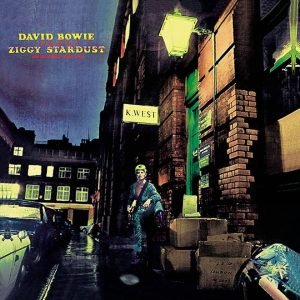Released on June 16, 1972, “The Rise and Fall of Ziggy Stardust and the Spiders from Mars” represents a pivotal moment in David Bowie’s illustrious career. Positioned within Bowie’s discography, this album is a dazzling leap into the avant-garde, both thematically and sonically. While his previous works, such as “Hunky Dory,” hinted at his flair for innovation and boundary-pushing artistry, “Ziggy Stardust” catapulted Bowie into the stratosphere of cultural iconoclasm, solidifying his place as a pioneer of glam rock.
In the broader music landscape of the early 1970s, the album stands out for its bold blend of rock, theatre, and science fiction. During a time when rock music was diversifying into various subgenres, Bowie harnessed these evolving trends and injected them with his unique vision. The album not only mirrored the flamboyance and rebellion of the glam rock era but also introduced a narrative depth that set it apart from its contemporaries.
Artistic Intentions
David Bowie aimed to craft a work that transcended the traditional confines of rock music, creating a multimedia experience that encompassed music, fashion, and performance art. With “Ziggy Stardust,” Bowie introduced the world to Ziggy, a fictional androgynous rock star from outer space who serves as the album’s protagonist. Through Ziggy, Bowie explored themes of fame, identity, and societal collapse, blending them with a futuristic mythology that captivated listeners and critics alike.
In interviews and album notes, Bowie expressed his desire to push the boundaries of what a rock album could be. He sought to challenge the conventional notions of celebrity and artistry, using Ziggy as a vehicle to comment on the transient nature of stardom and the alienation it often brings. By embodying Ziggy both on and off stage, Bowie blurred the lines between reality and performance, inviting his audience into a world where the music was just one part of a larger, immersive spectacle.
This ambition is evident not only in the album’s lyrical content but also in its production and instrumentation. Collaborating with producer Ken Scott and his band, The Spiders from Mars, Bowie crafted a soundscape that was as theatrical and flamboyant as Ziggy himself. The result is an album that remains a touchstone in the annals of rock history, celebrated for its audacity, creativity, and enduring influence.
Sonic Exploration

Production Quality
“The Rise and Fall of Ziggy Stardust and the Spiders from Mars” showcases a production quality that is both polished and evocative, balancing the crispness of studio precision with the raw edge of rock ‘n’ roll. Under the expert guidance of producer Ken Scott, who had previously worked with The Beatles, the album boasts a clarity that allows each instrument and vocal to shine distinctly. This meticulous production serves the album’s themes by juxtaposing the polished, larger-than-life persona of Ziggy with the underlying grit and turmoil of his narrative. The crispness of the sound enhances the album’s theatricality, making Ziggy’s journey through fame and decadence feel immediate and visceral.
Musical Arrangements
The musical arrangements on “Ziggy Stardust” are as bold and varied as the album’s conceptual ambitions. Mick Ronson’s guitar work is a standout, his riffs and solos providing a dramatic backbone that drives the album’s energy. From the crunchy, distorted power chords of “Suffragette City” to the haunting, melodic lines of “Starman,” Ronson’s guitar is both a sonic and emotional anchor.
The vocals, too, are masterfully arranged. Bowie’s voice shifts seamlessly from the swaggering bravado of “Moonage Daydream” to the delicate, almost fragile delivery in “Lady Stardust.” This vocal versatility not only showcases Bowie’s range as a singer but also deepens the character of Ziggy, presenting him as multifaceted and complex.
String arrangements, also orchestrated by Ronson, add a lush, cinematic quality to tracks like “Five Years” and “Rock ‘n’ Roll Suicide.” These orchestral elements elevate the album’s drama, blending seamlessly with the rock instrumentation to create a soundscape that is both grandiose and intimate.
Genre Elements
“The Rise and Fall of Ziggy Stardust and the Spiders from Mars” is a quintessential glam rock album, but its sonic palette extends beyond the boundaries of any single genre. It incorporates elements of hard rock, as evident in the driving force of “Hang On to Yourself,” and pop sensibilities, showcased in the catchy hooks of “Starman.” There’s also a touch of proto-punk in the raw energy and rebellious spirit of “Suffragette City.”
Bowie’s ability to blend these genres in a cohesive and innovative way is a testament to his artistry. The album’s glam rock core, characterized by its flamboyant style and theatricality, is enriched by these diverse influences, creating a sound that is as eclectic as it is unified. This genre-blending not only broadens the album’s appeal but also reinforces its narrative themes of transformation and reinvention.
Lyrical Analysis

“The Rise and Fall of Ziggy Stardust and the Spiders from Mars” is a rich tapestry of themes, woven together through David Bowie’s visionary storytelling. At its core, the album explores the rise and fall of its titular character, Ziggy Stardust, an alien rock star who becomes a messianic figure on Earth. Central themes include fame, alienation, and the apocalypse. The lyrics often delve into the intoxicating allure of stardom and its destructive consequences, as seen in tracks like “Star” and “Rock ‘n’ Roll Suicide.” The apocalyptic undertones are introduced in the opening track “Five Years,” which describes a world on the brink of collapse, setting the stage for Ziggy’s arrival and eventual downfall.
Recurring motifs throughout the album include outer space imagery, representing both Ziggy’s otherworldliness and the broader concept of escapism. Ziggy’s journey is a metaphor for the human condition, grappling with the pressures of identity and the transient nature of life and success. Songs like “Starman” and “Moonage Daydream” highlight Ziggy’s cosmic origins and mission, while “Lady Stardust” and “Ziggy Stardust” focus on his transformation and impact on society.
Lyrical Depth
Bowie’s lyrics on this album exhibit a remarkable blend of straightforward narrative and abstract poetry. Tracks like “Five Years” and “Rock ‘n’ Roll Suicide” offer vivid, almost cinematic storytelling, drawing listeners into Ziggy’s world with detailed, evocative imagery. For instance, “Five Years” paints a stark picture of societal collapse, with lines like “News had just come over, we had five years left to cry in.” This narrative clarity contrasts with the more abstract, metaphorical lyrics found in songs like “Moonage Daydream,” where phrases such as “freak out in a moonage daydream, oh yeah” leave room for interpretation and personal reflection.
The complexity of Bowie’s lyrics lies in their dual nature, being both accessible and profound. On the surface, they tell the story of Ziggy Stardust, but deeper listening reveals layers of meaning about fame, mortality, and existential dread. This lyrical sophistication invites repeated listening, with new insights and interpretations emerging over time.
Emotional Impact
The emotional resonance of “Ziggy Stardust” is one of its most enduring qualities. Bowie’s lyrics evoke a wide range of emotions, from the desolation and urgency of “Five Years” to the exuberant hope of “Starman.” Tracks like “Lady Stardust” and “Rock ‘n’ Roll Suicide” capture the loneliness and vulnerability beneath Ziggy’s glamorous exterior, making the character’s journey deeply relatable. The line “You’re not alone” from “Rock ‘n’ Roll Suicide” is particularly poignant, offering a message of solidarity and comfort amidst the album’s darker themes.
The lyrical content not only engages the intellect but also strikes at the heart, making the listener feel a part of Ziggy’s rise and tragic fall. This emotional depth is a key factor in the album’s lasting impact, as it connects on a human level, beyond the fantastical elements of its storyline.
Cohesion and Flow

“The Rise and Fall of Ziggy Stardust and the Spiders from Mars” is a masterclass in album cohesion, with each track flowing seamlessly into the next, creating a compelling narrative and emotional arc. The album opens with “Five Years,” a somber and foreboding prelude that sets the stage for Ziggy’s emergence. This track introduces the apocalyptic backdrop against which Ziggy’s story unfolds, immediately engaging the listener with its urgency and emotional weight.
As the album progresses, tracks like “Soul Love” and “Moonage Daydream” gradually build Ziggy’s character, adding layers of depth and complexity. “Starman,” with its infectious chorus and hopeful lyrics, serves as a pivotal moment, signaling Ziggy’s arrival and his promise of salvation. This progression feels natural, as each song adds to the narrative, enhancing the listener’s understanding and emotional connection to Ziggy.
The latter half of the album continues this trajectory, with songs like “Star” and “Hang On to Yourself” capturing the peak of Ziggy’s fame and the euphoria it brings. The transition to “Ziggy Stardust” and “Suffragette City” marks the beginning of Ziggy’s decline, with a palpable sense of tension and impending doom. The album closes with “Rock ‘n’ Roll Suicide,” a poignant and dramatic finale that brings Ziggy’s story full circle, offering a sense of closure and reflection. The careful sequencing of tracks ensures a smooth flow, maintaining the listener’s engagement from start to finish.
Thematic Consistency
The thematic consistency of “Ziggy Stardust” is one of its greatest strengths. Throughout the album, Bowie maintains a cohesive blend of styles and emotions that align with the overarching narrative. The glam rock aesthetic, characterized by theatricality and flamboyance, is present in every track, providing a unifying sonic and visual identity. This consistency extends to the lyrical content, which consistently explores themes of fame, identity, and existential angst.
Despite the diverse range of musical influences—spanning rock, pop, and orchestral arrangements—the album never feels disjointed. Each song, while distinct in its own right, complements the others, contributing to the larger story. For instance, the hopeful optimism of “Starman” is balanced by the darker, introspective tones of “Rock ‘n’ Roll Suicide,” creating a dynamic yet harmonious narrative arc.
Even in moments where the album shifts stylistically, such as the transition from the upbeat “Suffragette City” to the melancholic “Rock ‘n’ Roll Suicide,” these changes feel purposeful and aligned with the story’s progression. Bowie masterfully uses these shifts to mirror Ziggy’s journey, making the album not just a collection of songs, but a cohesive, immersive experience.
Standout Tracks and Moments
Highlight Key Tracks
1. “Five Years” The opening track, “Five Years,” is a powerful introduction to the album’s apocalyptic narrative. Its slow build, starting with a simple drumbeat and gradually incorporating piano, strings, and Bowie’s plaintive vocals, creates an intense emotional impact. The song’s vivid lyrics paint a dystopian picture of a world with only five years left, setting a dramatic and urgent tone for the rest of the album.
2. “Starman” “Starman” stands out for its infectious melody and optimistic message. The song’s catchy chorus, with its iconic “There’s a starman waiting in the sky,” captures the hopeful essence of Ziggy Stardust’s character. The track’s pop sensibilities and radio-friendly appeal helped it become one of Bowie’s most enduring hits, symbolizing the promise and allure of Ziggy’s arrival.
3. “Ziggy Stardust” The eponymous track “Ziggy Stardust” is a defining moment in the album, encapsulating the rise and fall of its protagonist. The song’s narrative lyrics detail Ziggy’s transformation from a charismatic rock star to a tragic figure undone by his own excesses. Mick Ronson’s memorable guitar riff and Bowie’s passionate delivery make this track a standout, both musically and thematically.
4. “Rock ‘n’ Roll Suicide” Closing the album, “Rock ‘n’ Roll Suicide” is a dramatic and cathartic finale. The song’s gradual crescendo, from its introspective beginning to its climactic conclusion, mirrors Ziggy’s own journey. Bowie’s powerful vocals, particularly the anguished cry of “You’re not alone,” offer a poignant message of solidarity and hope, leaving a lasting emotional impact.
Memorable Moments
1. The Emotional Climax of “Five Years” In “Five Years,” the moment when Bowie’s voice breaks as he sings “I never thought I’d need so many people” is profoundly moving. This raw display of vulnerability underscores the song’s apocalyptic theme and sets a high emotional bar for the rest of the album.
2. The Euphoric Chorus of “Starman” The chorus of “Starman” is one of the album’s most uplifting moments. The soaring melody and Bowie’s jubilant vocals create a sense of hope and excitement, perfectly capturing the allure of Ziggy’s otherworldly message.
3. The Guitar Solo in “Moonage Daydream” Mick Ronson’s blistering guitar solo in “Moonage Daydream” is a highlight of the album. The solo’s intensity and creativity showcase Ronson’s virtuosity and add a layer of cosmic grandeur to the song, enhancing its space-rock aesthetic.
4. The Poignant Lyric in “Rock ‘n’ Roll Suicide” The line “Oh no, love, you’re not alone” in “Rock ‘n’ Roll Suicide” is one of the album’s most memorable and emotional moments. Bowie’s delivery, coupled with the swelling orchestration, creates a powerful sense of connection and reassurance, encapsulating the album’s themes of alienation and solidarity.
5. The Transition from “Lady Stardust” to “Star” The seamless transition between “Lady Stardust” and “Star” is a subtle yet effective moment that highlights the album’s cohesion. The reflective melancholy of “Lady Stardust” gives way to the exuberant energy of “Star,” mirroring the duality of Ziggy’s character and maintaining the narrative flow.
Artistic Contribution and Innovation

Place in Genre/Industry
“The Rise and Fall of Ziggy Stardust and the Spiders from Mars” holds a seminal place within the glam rock genre and the broader music industry. Released in 1972, the album arrived at a time when rock music was diversifying, and it played a pivotal role in defining and popularizing glam rock. With its flamboyant style, theatrical presentation, and conceptual depth, “Ziggy Stardust” not only pushed the boundaries of what rock music could be but also set new standards for artistic expression and performance.
Within the glam rock genre, the album stands alongside works by T. Rex and Roxy Music, yet it distinguishes itself through its narrative cohesion and the creation of an alter ego that blurred the lines between artist and character. Bowie’s embodiment of Ziggy Stardust on and off the stage was a groundbreaking approach that influenced not only his contemporaries but also future generations of artists across various genres.
In the music industry at large, “Ziggy Stardust” challenged the status quo by merging rock music with elements of theatre and science fiction, creating a multimedia experience that extended beyond the album itself. This holistic approach to artistry and performance was innovative for its time and has had a lasting impact on the way artists conceptualize and present their work.
Innovation
One of the most innovative aspects of “Ziggy Stardust” is its conceptual framework. By creating a fully realized character and narrative, Bowie transformed the album into a cohesive story that explored themes of identity, fame, and existential crisis. This concept album approach was not entirely new, but Bowie’s execution was particularly sophisticated and influential, setting a high bar for future concept albums.
The production quality of the album also stands out as innovative. Producer Ken Scott, along with Bowie’s band The Spiders from Mars, crafted a sound that was both polished and raw, blending studio precision with the energy of live performance. The use of layered instrumentation, including Mick Ronson’s dynamic guitar work and lush string arrangements, created a rich, textured sound that was ahead of its time.
Bowie’s approach to genre on this album is another key innovation. While rooted in glam rock, “Ziggy Stardust” seamlessly incorporates elements of hard rock, pop, and even proto-punk. This genre-blending not only broadened the album’s appeal but also demonstrated Bowie’s ability to transcend musical boundaries and create a unique, genre-defying sound.
Thematically, the album broke new ground by tackling complex and often dark subjects within a popular music context. The exploration of androgyny and alienation through Ziggy Stardust’s character challenged societal norms and opened up new avenues for artistic expression. Bowie’s willingness to address issues of identity and the human condition in such a direct and provocative manner was revolutionary.
Furthermore, Bowie’s visual presentation and stagecraft were integral to the album’s impact. The elaborate costumes, makeup, and stage personas that Bowie adopted for the Ziggy Stardust tour were pioneering in their use of visual art to enhance and expand the musical experience. This fusion of music and visual art has since become a staple in the industry, influencing countless artists and performers.
Closing Thoughts

“The Rise and Fall of Ziggy Stardust and the Spiders from Mars” is a masterwork of musical and artistic innovation. Among its strengths are its cohesive narrative structure, impeccable production quality, and genre-blending sound. Bowie’s creation of the Ziggy Stardust character and his ability to seamlessly merge storytelling with music set a new standard for concept albums. The album’s themes of fame, identity, and existentialism are explored with depth and sophistication, making it not only a sonic delight but also an intellectually stimulating experience. Tracks like “Starman,” “Ziggy Stardust,” and “Rock ‘n’ Roll Suicide” are standout moments that showcase Bowie’s exceptional talent as a songwriter and performer.
The album’s production, led by Ken Scott, achieves a balance between clarity and raw energy, allowing the intricate arrangements and Bowie’s dynamic vocal performances to shine. Mick Ronson’s guitar work is particularly noteworthy, adding both melodic and textural richness to the album.
While the album is overwhelmingly strong, if one were to identify a weakness, it might be that its ambitious conceptual nature and stylistic eclecticism can be challenging for some listeners to fully grasp on the first listen. However, this complexity is also one of its greatest strengths, rewarding repeated listens with new layers of meaning and appreciation.
Impact and Legacy
In the context of David Bowie’s career, “Ziggy Stardust” is a transformative work that solidified his status as a musical innovator and cultural icon. It marked a departure from his earlier work and laid the groundwork for his continued exploration of new artistic directions. The album’s influence extends far beyond its initial release, inspiring countless artists across genres and shaping the evolution of rock music and performance art.
For listeners, “Ziggy Stardust” offers an immersive experience that is both entertaining and thought-provoking. Its themes remain relevant, resonating with new generations of fans who find solace and inspiration in Ziggy’s story. The album’s ability to connect on both an emotional and intellectual level ensures its place in the pantheon of rock’s greatest achievements.
Official Rating
Giving “The Rise and Fall of Ziggy Stardust and the Spiders from Mars” a rating of 10 out of 10 is a testament to its unparalleled artistry and enduring impact. This perfect score reflects the album’s flawless execution of a complex concept, its innovative blend of musical styles, and its profound thematic depth. Bowie’s vision, combined with exceptional performances and production, results in an album that not only stands the test of time but also continues to influence and inspire. “Ziggy Stardust” is not just an album; it is a cultural milestone that redefined what music could be, earning its place as a cornerstone of modern music history.
